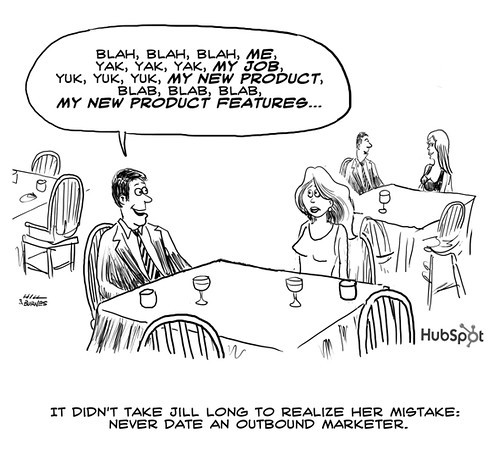Continuous innovation in marketing and other areas….can be hard. But, it doesn’t have to be….
November 19, 2012Using your talent management programmes to build a customer focused culture
November 23, 2012Inbound and content marketing may make up 80% of all marketing in the future – Interview with Mike Volpe of Hubspot
In Inbound marketing is about content and context, I reported back from Inbound Marketing UK. However, whilst there I was able to catch up with Mike Volpe, the Chief Marketing Officer of Hubspot, who was speaking at the conference. In the interview, we talked about inbound marketing, where people should start, how much of their marketing should be inbound/content focused and a bunch of other things.
This interview makes up number thirty-seven in the series of interviews with authors and business leaders that are doing great things and helping create businesses that customers love.
Below are highlights from our interview:
- Hubspot have just raised another $35million to help build their business. Mike says that if you have successful customers and your business is growing then people want to invest.
- The rise of inbound and content marketing is coming about as more and more businesses realise that the customer is now in control as they have the power to skip your ads, screen out your cold calls and junk your direct (e)mail.
- Once businesses realise this then they realise that their marketing needs to be turned around the other way and increase their inbound and content marketing efforts.
- Most businesses have about 10% inbound and 90% traditional marketing and they do need to make a shift into more inbound and content marketing.
- Hubspot’s lead generation, effort and spend is 75% inbound and content marketing and 25% more traditional marketing. They think that 80:20 is probably the right ratio.
- Their inbound leads cost them half as much as leads from traditional marketing methods and they close into customers at three times a higher rate.
- Mike says that for anyone wanting to get started with inbound and content marketing then blogging is a great place to start. Many people don’t blog enough and spend more time on different social networks and Mike believes that they miss the underpinnings of a good inbound strategy ie. developing a home base and building up a base of things that they are contributing to their community.
- Anyone in your organisation who has value to add to the buying personas that you target should be creating content or, at least, helping to create content….from the CEO all the way down to the front-line employees. The whole goal being to use whatever resources you have to provide value to your customers or potential customers.
- If you want to grade your entire marketing funnel and find out how to improve, then Mike suggests that we check out Hubspot’s free tool: Marketing Grader (marketing.grader.com)
About Mike (taken from his LinkedIn profile)
I joined HubSpot as one of the first 5 employees, and since then we have grown to one of the top marketing software companies with over 4,500 customers and 220 employees.
In marketing, we have created a sophisticated lead generation machine, supporting over 60 sales reps by generating over 35,000 leads per month, all of which are scored and prioritized based on custom designed algorithms that estimate the probability of a lead closing into a sale, with the best leads going to the sales team, and the other leads going into a lead nurturing program with about a half-dozen different segments.
We also built a top brand in our market, created the largest social media presence for any B2B software company, won many awards for our marketing, generated over 600,000 views for our YouTube videos, built one of the top 10 marketing blogs, and grew a large online community that loves HubSpot. HubSpot’s marketing practices have been featured in over 20 different business and marketing books.
You can connect with Mike on Linked In here, Twitter via @mvolpe and check out Hubspot and their blog too.
Thanks to Hubspot for the image.
Note: Given my experience with blogging and social media etc I am helping a number of clients with their inbound and content marketing needs, at the moment. If you want to talk about and how I could help your business too in that area then get in touch here. Alternatively, to stay in touch and get access to more ideas not published here on the blog, then do sign up for my monthly newsletter here.





74 Comments
Thank you for the link to marketing.grader.com that should keep me out of my wife’s hair for a while
James
Cheers James,
What score did you get?
Adrian
81, though I am not sure if that is out of 100 or 1000
I just scooped 85 and I’m going to tell myself that it’s out of 100 so that I can be in the upper quartile 😉
Hello Adrian
I get it and I have been grappling with this when it comes to my clients. The challenge around switching from traditional marketing to content marketing is huge. It occurs about as attractive as asking a couch potato to run a marathon! The idea is great and it is not likely to happen anytime soon: it occurs as too damn hard. And
Then there are people who get off the couch, start running and quit. It is just too damn hard: just cannot get the people who are in the best position to create content to create content. And then there are the rules around who can and can’t write content, the tone of voice, the message and the legals. Too much effort – it shows up as swimming in treacle. Tired, these people give up.
There is a third category, those that expected instant results. So they get off the couch, run and then run some more. And now they are disappointed because after a week of running they can’t run a marathon! In the business world is that the instant leads and revenues don’t show up.
To sum up, there is reason that traditional marketing dominates. It is easy for marketing depts. They create a brief and the works is outsourced to outside specialists who are great at design, copy, tv, digital etc. Reason inbound is so small – the expertise needed to write good content is not widely distributed in the organisation. And it does have to come from within the organisation.
Maz
Hi Maz,
You are very right and pinpoint many of the reasons why organisations fail at inbound and content marketing.
However, I think the reality is that there is a shift in control from businesses to their customers and businesses need to realise this, embrace and make the changes regardless of the pain that may involve. That may require a lot of retraining or many people changing jobs.
Many will put it off for as long as they possibly can but the quicker they embrace the pain of the training programme the quicker they will be able to run the marathon that they know they have to run.
Adrian
Everything is very open with a really clear description of the challenges.
It was truly informative. Your website is very
helpful. Thanks for sharing!